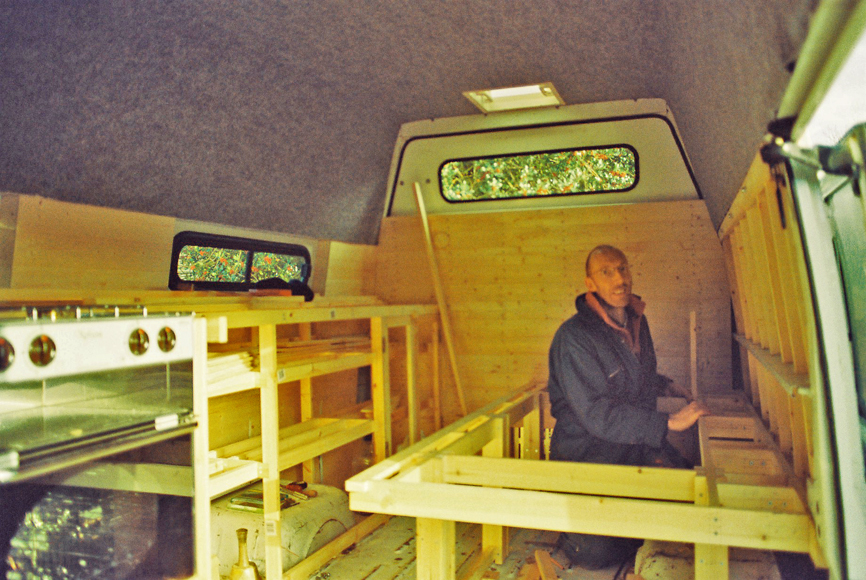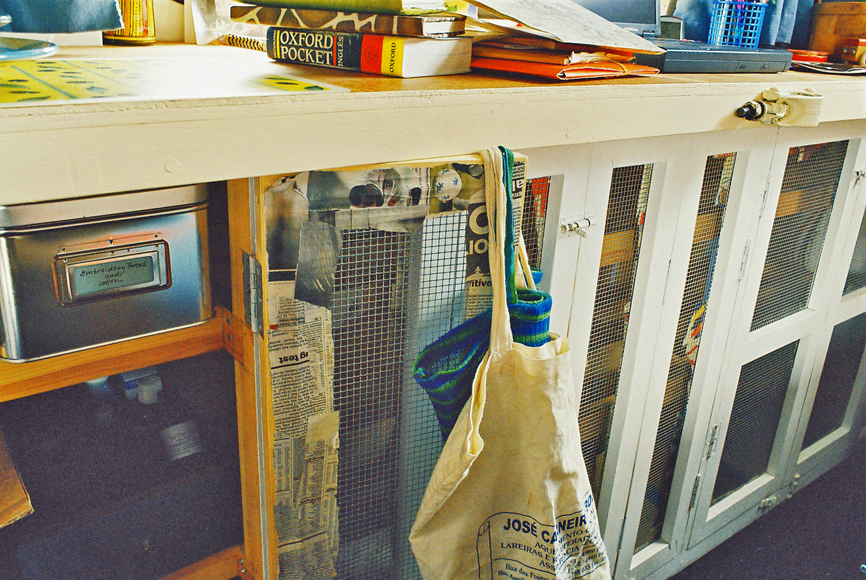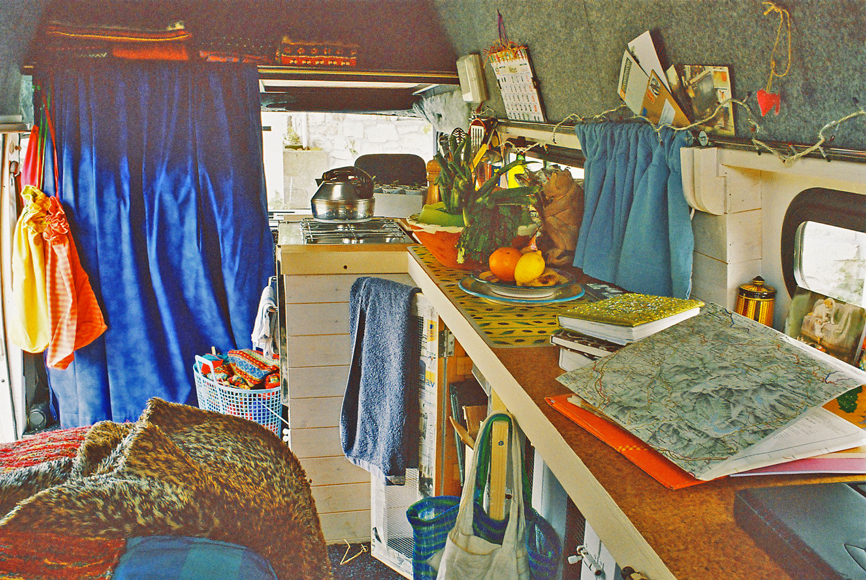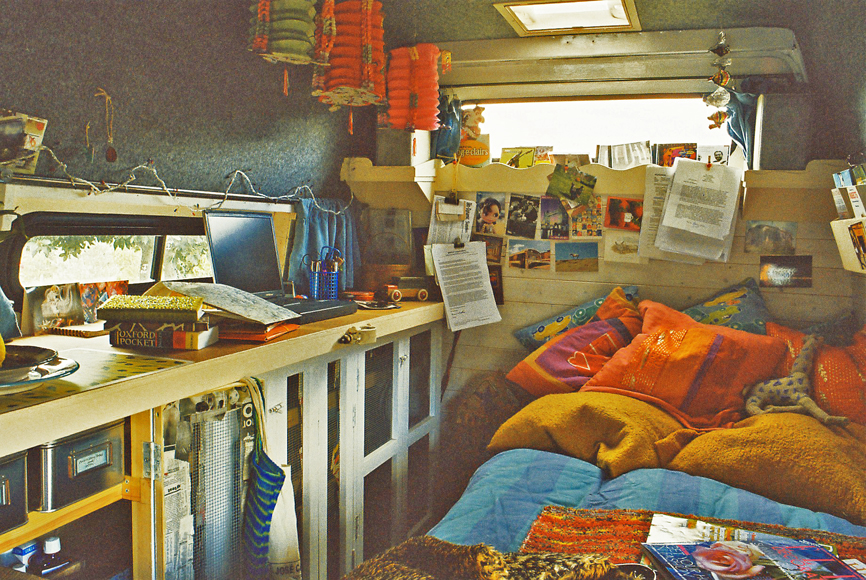swipe to see more photos
This page
is all about living in vans, based on our experience. About converting one, travelling through Spain & Portugal (most of the information here relates to these two countries), and what we learnt from all the other nomads we met along the way. It’s not an easy life, but to search for land remains the only way. We’d never done anything like it before, so made plenty of mistakes, but hopefully after reading this you will have a much more rewarding experience.
*
THE POLICE & THE LAW (for EU countries only)
Wild camping, as it is more commonly known (parking for an extended period outside an officially recognised campsite), is probably illegal everywhere by now (apart from Scotland). This doesn’t mean you can’t do it, thousands upon thousands of van nomads (yes there really are that many people living outside conventional society), plus conventional campervanners continue to park up this way. You just have to think and behave in a way that attracts the least amount of attention. For example, if you are parking up in an urban area always ask first at the local town hall (or police station) if it is okay, and where would be best. Or turn up really late, when officialdom has gone home (police in rural areas work office hours), making sure to be away early enough the next morning. Don’t park in large towns or cities. Not just because the police will be a lot more zealous (they will, especially if you have foreign plates), but there’s a real possibility of violence and theft. Always park in the most visible/ public and well-lit places. Two popular choices are supermarket car parks and lorry parks.
If you need to stay somewhere longer than a night (or two) then it is best to find someone local who has a piece of land to rent, so you are technically off the road. This way you can also have the local Post Office deliver (or save) mail. Parking up for a while also allows you to get loads of washing done and to get to know the neighbourhood.
There is a law in the EU which states you cannot drive a vehicle registered in another country, for more than a set number of days per year (sorry I don’t know how many), without having it re-registered in the country you are currently in (along with your driving licence). The punishment for ignoring this is seizure of the vehicle and a substantial fine. Unlike the TV Licence van this can actually happen, though the chance of randomly being stopped by the police is virtually zero, as they have no way of knowing how long you have been in the country. However, you can be reported by a member of the public. This happened to a couple we knew who had been living in a spanish town for many years with a UK registered vehicle. They fell out with their neighbour over something and in retaliation he informed the police about the van.
You’re also supposed to tell the DVLA if you are going abroad for an extended period (though they don’t specify what that is). As well as return each year for the MOT, as well as keep your Road Tax up to date, though if you no longer have an address that will be tricky. I have never been asked to provide proof of either, or have been stopped at roadblocks (common in Spain & Portugal) more times than I can remember.
Obviously, you must have insurance (along with a green card), and your insurer has to know (in writing) it is a conversion.
Keeping the MOT up-to-date is another grey area. We made sure it was just in case there was a claim on the insurance. In some countries (Spain for example) vans over 10 years old are required to be inspected every six months. The centres in the EU are also a lot stricter than in the UK. Some may refuse, on the grounds that it is a right-hand drive, but we never had any problems. If you are mechanically challenged (like us) then keeping the MOT up to date is also a perfect way to keep on top of potential problems, especially as in some rural areas you can wait up to three months to get repairs done.
Remember to carry all the mandatory emergency equipment, which must have the appropriate EU kite mark. Stuff like reflective triangles (often more than one is required)/ reflective vest/ spare tyre/ spare light bulbs/ fire extinguisher/ breathalyser/ etc. Each country has its own list. Plus, you’ll need to carry at all times the vehicle’s documents, including all the previous MOT paperwork + current driving licence (do not let this expire or have less than a month left)/ and passport (which have to be on your person at all times anyway). Photocopies of any of these are not acceptable.
If you are intending to park up somewhere for more than a few weeks life gets a bit more difficult. In Spain for example, you might have to register as a resident. First at the local Town Hall, which isn’t anything sinister (it’s so they can claim more money from central government), which just takes a few minutes and often costs nothing. After that it gets painful (and expensive). You will need a national residency certificate or identity card, which in Spain they take very seriously. For this you have to report to the Police Headquarters and be interviewed. Technically you’re an immigrant, and they have to make sure you are entitled to be in their country. You’ll be required to provide at least the following (photocopies are not acceptable), and possibly more (check on the country’s website):
- several copies of an up-to-date photograph of yourself
- have your fingerprints taken
- evidence that you have sufficient income
- birth certificate
- marriage certificate
- proof of registering at the local Town Hall
- evidence that you have private health insurance
- evidence that you have an income or sufficient savings to live for several years
There is only one office in each region where you can do this, typically situated several hundred kilometres away from where you are. Where you’ll have to visit several times. You’ll probably need an appointment, and even then, have to queue on the day, so get there several hours before the time stated. Make sure to take ALL the papers you have, or you will be turned away. There is a charge payable.
We did really well, compared to people we’ve met since, but still nearly went mad trying to get it all sorted. But at least you come away with something, and that’s the vital identity number it gives you, without which life is virtually impossible. Providing you with the right to claim unemployment and social security benefits, and in some countries free NHS health care.
Finally, you’ll need to surrender your UK driving licence, to get one issued by that country (which could mean not being able to drive large vehicles). This is done in person at the regional office, and it’s like doing the residency bit again, but this time the staff are really nasty (and in the case of foreigners usually have no idea what they are doing). Keep your cool, it’s not personal, they treat everyone like this. It will also cost money, including paying for a medical test. The latter you can get done at a private health centre and involves no more than answering a few health questions (mostly about your state of mind for some reason), a quick test of coordination with an ancient video game, and a test for colour recognition. There is no physical examination, nor will you be seen by a medical doctor. A final word of advice do not let your UK licence expire before attempting any of this.
*
PARKING
In some countries (Portugal for example) you can only park on the side of the road when facing in the same direction as the traffic flow. Make this a habit and you won’t get caught with an on-the-spot fine. Be aware too of all the yellow/ blue lines and any other restrictions that might apply. Some local council enforcers are really zealous about these and make the town a nice extra income from enforcing them. When choosing where to park always consider the potential for damage by other drivers and disenchanted youth. In some countries most of the older citizens will never have taken any kind of test, nor do they have perfect vision, or learnt anything from all their years on the road, so the potential for being bumped/ scratched/ or having bits torn off (always fold in the side mirrors) is always there.
New drivers also tend to treat their vehicle as if they are in a video game, oblivious to the dangers. Therefore, always expect the stupid and be ready to take evasive action, even if it’s on a blind bend or with on-coming traffic. If you get flashed at or hooted don’t panic. It’s either they’ve thought to let you know they are about to do something crazy or want to rob you.
*
FINES
Getting pulled over by the police (traffic and local) and fined is probably going to become a regularity. Each day (thankfully at the same time and usually in the same places) they mount roadblocks. Generally, on the faster and busiest routes, but also haunt areas where there are plenty of tourists. The secret is to travel outside these hours (normally it is during rush hour), stay on the smaller roads, and always keep an eye out well ahead. The way they target tourists is more surreptitious, usually hiding in a side street, watching for foreign plates, then suddenly appearing behind you. Always observe all the traffic signs (maximum speed and STOP especially), even if it irritates the hell out of all the other drivers. And if they stop you, expect to be asked to pay (in cash) for some bogus infraction. The only way to avoid this is to make sure you have nothing more than loose change in your pockets and no ATM cards, then brazen it out. Do not try to speak in their language, just keep repeating you refuse to pay. They will try and intimidate you (with a show of their guns and by calling reinforcements). Stay cool and demand to be taken to the police station. If it comes to that, ask to make a formal complaint. They should give up at some point but be ready for it to take all day. Keep in your mind that it’s your money, and you are dealing not with the law here but just a bunch of kids in uniform who are a lot more frightened of what you could do.
*
SECURITY
Oddly enough, for us this was never an issue. Because we always kept away from cities/ large towns, and in the tourist spots parked up where there were always a lot of people. The only case we heard of was when a friend went for a swim on a deserted beach and came back to find her car had been broken into (all her papers stolen and took six months to replace). Leave the van somewhere safer and walk/ cycle instead. Alarms are pointless, they just get ignored or irritate people sufficiently to try and turn them off. Chances of anyone driving the van away depend on how valuable it is. I would recommend fitting an immobiliser.
*
BUYING A VAN
Obviously, what you’re going to get depends on what you’re prepared to pay, or the work put in converting it. If your plan is to eventually trade it in, bear in mind to spend no more than is economic and bear in mind the only buyers will be fellow nomads who probably have little or no money. We planned on keeping it long enough to find land and then park up off road (so not liable for re-registering) for the house building phase (also neatly circumventing laws on caravans and mobile homes), afterwards using it as additional accommodation for friends to stay.
Size is everything, when you live in a van for any length of time. It is not natural or pleasant to be confined in such a small space, especially when accompanied by all your belongings/ pets. Buy the biggest your licence allows and make sure there is sufficient headroom to stand up inside and put a bed in sideways. Don’t worry if it looks like a lorry, anything that can be driven on a normal licence can get round the tinniest pueblo roads. Contrary to logic, bigger vehicles do not consume substantially more fuel. Ours, a 2.5 litre DAF CONVOY LWB H2, with 4 wheels on the back and rear-wheel drive, managed an average of 45 miles to the gallon. They are also much easier to drive, the seats are better, the raised driving position gives a better view, and the coach-style steering wheel angle is more comfortable. A high body clearance also makes them good for roads/ tracks that don’t have tarmac (very useful in Portugal). The only things ours didn’t like was mud, sand, and cambers (I turned it over twice on those).
You need to choose a make that can be repaired anywhere, especially the engine. We thought our model was like that (every public service in the UK used them), but no-one in Portugal would touch it, and in Spain we had to get the parts shipped out. I would therefore recommend a Mercedes (particularly the Sprinter, especially the minibus version). Obviously with a diesel engine, at least 2.5 litres, and left-hand drive.
Metal roof, not fibreglass. This lasts much longer, and you’ll need it to fix/ take the weight of a solar panel, as well as resist the heat of a stove pipe.
The best van we ever saw was ex-NATO military truck, though I have no idea what it was. Really high and looked so solid there didn’t seem to be anywhere it couldn’t go, probably bulletproof too. I would imagine came with an impeccable service record too. Worth finding out who sells them and at what kind of price.
*
THE CONVERSION
Our van was sourced by our local garage and cost us nothing, instead we traded our far newer much smaller van. Further expenditure was kept to a bare minimum. Despite having been checked over, and accompanied by a full-service history, the first impression was not a good one. Inside there were various alien life-forms thriving. A new speedometer had been fitted, set to nought. The rubber flooring had trapped spillages underneath and was rusting the metalwork. Externally the rear doors had been stoved in.
We started by washing everything down, which took two whole days. Then had the rear doors removed and replaced with a welded panel which has a window high enough up for anyone passing not to see in.
Fitting-out started with bolting a wooden frame to the metal wall struts. Insulation came next, followed by tongue & groove panelling. By then I’d realised the inside walls were not vertical, so everything else was made free-standing then bolted onto the walls. If you use bolts make sure they are the type that lock with a nylon sleeve, or the vibration when driving will undo them.
Deciding what we would need to take with us was difficult. Neither of us had been camper-vanning before, and what we’d seen in showrooms we didn’t like, but luckily the lack of space limited the choices.
We bought all the materials from local diy stores, and it soon became apparent that they were a lot heavier than the plastics and laminates used in conventional campervans, so I regularly visited a public weighbridge, to check the load on each wheel/ axle against the maximum permitted on the van’s VIN plate.
Designing and building the bed took the longest. Ideally it would have gone across the new rear wall, like a bunk bed, but I’m very tall and felt this would be uncomfortable over a long time. A mistake in retrospect, because located along the side wall took up a lot more floor space. I used the idea of a futon sofa-bed, so at night opened out as a double bed. On the opposite wall was a continuous worktop, with cupboards underneath, and the cooker. Books and small things went on shelves (with fronts) on the walls.
Above the cab I made a shelf for more storage.
We only had three months to do all the work, and even working full-time/ seven days a week that really wasn’t nearly enough. Ideally we shouldn’t have not given ourselves a deadline, especially when it came to installing the wiring.
*
ELECTRICITY
There’s a full account of how we did this (and got it so wrong), on the alternative energy page. Based on that and what we now know, I recommend the following:
- at least one lightweight 12 volt/ 200 watt solar panel. Mounted on the roof (with waterproof plug for quick detachment). Fit so there’s a gap underneath to allow air to circulate. You will also need to add a deflector in front to stop drag & noise when driving.
- a suitable rated breaker switch
- a charge controller (with read-out display in volts/ watts/ amps)
- a 100-200 w AC/DC inverter (for use with 220-240v AC appliances)
- a sealed lithium battery as the power source when it is dark.
- plus 12 volt led interior lights and a car stereo for music/ radio.
*
GAS
Plan on using the larger (13 kg) domestic type of propane/ butane bottles (camping gas is far too expensive and hard to find). In Spain and Portugal these are used by everyone for cooking and heating, so are readily available everywhere 7 days a week (at petrol stations/ builders’ merchants/ bars/ and supermarkets). Do not take a UK one with you as they are not refillable abroad and the connectors are not the same. At approximately 60 cm high x 30 cm diameter they are big and heavy (around 20 kg), but this should give you at least eight weeks of use. Replacing them is a lot cheaper than in the UK and prices change weekly. To acquire one, you’ll need to find the official distributor in that area and pay them a refundable deposit, after that you can simply swap it for a full one anywhere. There are at least two major brands, they all have the same fittings, and at least two types – standard or lightweight. Avoid the latter, as they work out a lot more expensive. To connect the bottle you need a valve, these are available from the supplier when you get the first bottle or builders’ merchants and domestic appliance shops. Let them show you how to attach the valve as it is not easy first time. You’ll also need a length of 9 mm rubber hose and a couple of jubilee clips to connect to the appliance. If you have more than one appliance, a copper t-piece too. The hose is guaranteed for five years and has the expiry date stamped on it, do not use after this date. Given the stability of such a large bottle in a moving vehicle, it will also need to be strapped down. We had ours in an airtight cupboard, just in case it leaked and poisoned us, but in hindsight simply taking the valve off when not in use is just as safe and you can install a carbon monoxide detector somewhere close to the floor. Don’t run a heater off gas, it creates far too much moisture and is probably toxic in such a confined space.
*
HEATING
Vans can be excruciatingly cold in winter (and well as too hot in the summer – see the bit about awnings), even in southern Europe, and when well insulated. They get really damp too, from all the condensation. The answer to this is to cut a hole in the wall, near the floor, and install a sliding ventilator. A small wood stove is probably the best solution for heating. Securely bolted down and sat on a sheet of metal, so if any embers fall out they don’t cause a fire. Hardware shops in Spain & Portugal sell them, though typically only during the winter, but they aren’t really designed for this, so I would suggest checking out one like the Nomad Oven PRO or make your own from an old gas bottle. Make sure the flue is of good quality stainless steel, fits in the top of the stove (not the back) and goes straight up, no bends. Install a damper in the flue too, so you can turn the stove right off. On the roof make sure the flue is as far away from the solar panels as possible, and fit a hat to prevent the rain getting in. When using the stove, burn it as hot as possible to keep the flue clean, and sweep the flue at least once a year. You’ll also need somewhere to store and keep firewood dry.
*
WINDOWS
Our van didn’t have any, so we installed bus/ canal boat types, which are about six inches high (so impossible to climb in through) and come in different lengths. Unfortunately this wasn’t sufficient to illuminate the interior and the mosquitoes got in when they were open, so we installed two small (30 cm x 30 cm) skylights (with mosquito screens), which tilted in different directions to catch the slightest draft. In retrospect these should have been bigger to let in more light.
*
WATER
Two people need around 75 litres a day (including for washing). Conventional campervans use a water tank for this. Which obviously works, but also adds significantly to the load (1 litre = 1 kg) and increases petrol consumption. Algae forms quickly in these tanks too. What we used instead were 5 & 25 litre containers, the latter strapped down, with a lightweight shopping-trolley frame to carry them for re-refilling. In the villages of Spain and Portugal most people prefer to get their drinking water from a local spring, so just ask where the nearest one is.
*
WASHING
Clothes washing was a big problem (particularly drying them). Outside big towns and cities there weren’t any launderettes, so we did it when and how we could. Body washing was a lot simpler. Simply boil a saucepan of water, pour into a bowl (with the juice of a lemon) and using a flannel wash from head downwards. No need for rinsing off afterwards. We also used the public baths, which in Portugal were in every town, fully staffed, very modern, and cost around a euro (for a hot shower, take your own soap & towel).
*
COOKING
You can buy really good gas stoves for caravans and boats, with all the same facilities as a conventional one, but on a smaller scale. Ours has two gas burners/ a grill/ and tiny oven. It cost a small fortune but has lasted 23 years in daily use so far.
*
FOOD
Living in such a small space means a lot of adaption, including how and when you shop, as well as what you eat. Outside the cities, supermarkets are rare. Instead, people buy their staples from small local shops, and fresh from the municipal fruit & veg market. Which means most of what you have been used to will not be available, or a lot more expensive. But you do get instead a wide choice or very cheap fresh and nutritious food grown by local people. Markets are generally only open in the mornings, probably not Monday, and sometimes only Saturday. Do not waste precious space in the van (and money) installing a fridge, keep that kind of stuff in a polystyrene cool box.
*
SLEEPING
Take your mattress from home, along with the usual arrangement of duvet/ sheets/ blankets etc. We tried cutting down by using sleeping bags, but they were a disaster, freezing cold and really uncomfortable. You will also need a mosquito net at night.
*
AWNING
From day one we wished we’d got one of these. Keeps the doorway area dry. Somewhere to hang out washing & wet things. Adds to the available space. Best of all, stops you going mad. Have a go at making one rather than spending a fortune on a ready-made version, and bear in mind it can be really windy at times.
*
TOOLS
This is another thing we left behind (to keep the weight down) and turned out to be absolutely essential. Not only the odd one for emergencies, but later when building our new home. The tools in Spain & Portugal are generally poorly made. Take as many as you can find room for, especially hand tools. Also: a portable workbench/ extension lead (25 m or more)/ digital multimeter/ soldering iron/ digital tyre-pressure gauge (check tyres weekly) & foot pump/ fire extinguisher/ wind-up & solar torches/ and if your van has six wheels an extension piece to attach the air hose.
*
HEALTH
Now we are no longer part of the EU if you need to see a conventional (NHS type) doctor abroad you will have to pay, both at state and private facilities. The quality of service in Spain & Portugal is on a par with the UK, but ambulances can literally take several hours to turn up. Alternative medicine practitioners abound, especially homeopaths and acupuncturists. For these expect to pay around 30 euros a session and around 5 euros for tablets. There are pharmacies in every town, and they can get homeopathic remedies within 24 hrs. Buy the most comprehensive first aid book you can afford, and always carry a full selection of first aid materials.
*
INTERNET
When we first set out, in 2000, there was no mobile phone coverage outside cities. To use the internet you searched for an internet café and the speed was incredibly slow. Today at least one bar in every town has free wi-fi, the town hall provides hot-spots, and most stationery shops & newsagents can print documents from a pen drive or mobile phone.
*
FINALLY
Other van dwellers are a great source of information and support. Don’t ever feel shy about parking next to one and knocking on their door to say hello. Generally, they love the company. We shared many memorable evenings like this, with people from all around the world, each of whom had had incredible experiences to recount. We learnt far more from them than we could have otherwise ourselves.
Here’s some photos of the interior.
swipe to see all the photos





















Really nice! Thanks for sharing!
LikeLike
very useful thanks for shearing 😉 jo xx
LikeLike
a good topic with excellent advice, thank you!
LikeLike
This is fantastic. Thank you.
LikeLike
Just spent a day reading your site; what a strong/practical person you are, well done. I’m not/haven’t been a ‘green person’ but you put a very strong case for going done that line, you’d be the ultimate neighbour. Sorry for your loss and hope you find true happiness with your new partner. Best wishes. Andy.
LikeLike